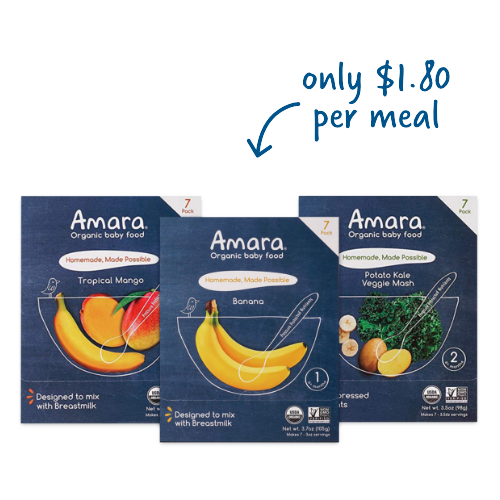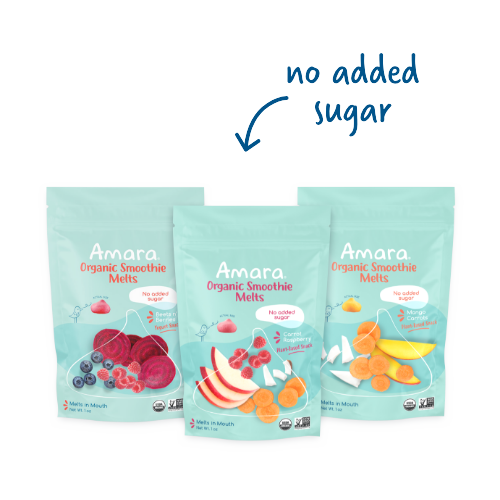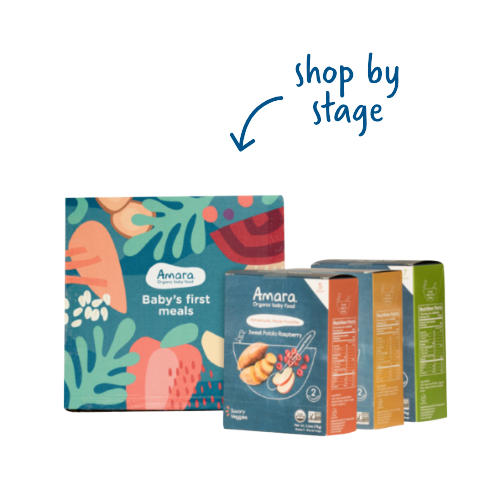Baby Feeding Schedule
0-6 months
WHO (World Health Organization) and American Academy of Pediatrics recommend for the first 6 months of life exclusive breastmilk or formula milk. Breastfeeding or human milk are the normative standards for infant feeding. Health professionals recommend that breastfeeding begin within the first hour of a baby's life and continue as often and as much as the baby wants. There will be times were many feedings can be expected, especially if baby isn’t sleeping for long or has growing phases!
6+ months
Around this age most infants reach a general and neurological development where they are prepared to start chewing, swallowing and digesting baby food. If so, it’s time to start with Amara purees!
Here are some "readiness signals", or signs that your baby wants more than milk:
- At the age where his/her birth weight has doubled normally
- Head control improves
- Your baby starts bringing toys to his/her mouth or starts exploring everything by mouthing
- Can close mouth around a spoon
- May start to show interest in what you are eating
- Is swishing milk around in their mouth
- Can sit upright
You can start serving vegetables like carrots, pumpkin, zucchini, peas, fennel, turnip. First start one by one, or mixed with some cooked potato, always well blended and may also be served with some butter or oil.
You can also start with soft, sieved ripe fruits. This can be in combination with baby cereal. It is important that the cereal is suitable for babies (precooked).
At this age, it is important to offer the food as fine, well blended purees. Normally the first tries will not be more than one or two spoons. Once the baby has learned to swallow the food, you can increase the amount and composition of the meals. From 6+ months, this is the complementary food stage, you may still use breastmilk or formula milk.
8+ months
The meals will be based on vegetables, potatoes, cereal, meat or fish, butter or oil, and fruit continue to be the same. Normally, the amount eaten per meal or the amount of meals besides the breastmilk or formula will start to increase. At this stage, the puree does not need to be very fine, it can be a little more course and rough in texture.
At this age, you can start to also include some legumes (lentils, beans, etc.) to the meals of your baby.
10+ months
Time to check for finger foods! Does baby do this?
- Pinch things with their fingers
- Put everything into their mouth
- Make chewing motions
- Can move things from one hand to another
Then it’s time to try these:
- Mashed or pieces of soft fruits and vegetables
- Baby finger foods
- Small bits of meat
- Well-cooked legumes
- Plus everything else from earlier, even breast milk!
Tiny pieces of fork-mashed foods like cooked potatoes, soft vegetables, lean meats, chicken, fish, egg, lentils or beans are great at this baby stage too.
12+ months
Almost ready for solid food all the time! Does baby do these?
- Swallow food easily
- No longer pushes food out of their mouth
- Growing teeth
- Wants to use a spoon
Then you can add
- Cut soft fruits
- Combination foods (mac and cheese)
- Bite-sized cooked soft vegetables
It is time to start participating more and more in the family dinner table. Remember to avoid fried foods and foods with too much salt or seasoning - this will help cultivate healthy eating habits for the whole family. A regular serving of vegetable, fruits and whole grains is important here as well.
How much to feed?
Every baby is different! Some eat more, some eat less. As baby eats more solid food, their desire for breastmilk and formula will naturally go down. Use Amarapurees to keep nutrition levels high when starting to introduce solids to your baby's feeding schedule.







Leave A Comment